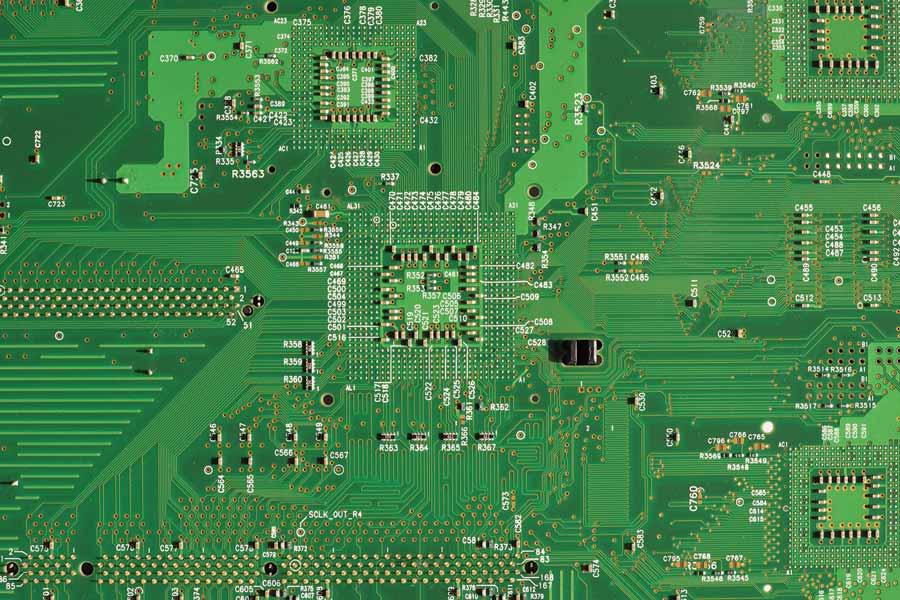Modern PCB designs are expected to be high speed, multi-functioning, and have tight board space utilization. And, PCB materials must be of high quality, resistant to temperature variations, and easy to handle. One widely-used type of PCB dielectric material that exhibits many of these desirable qualities is FR4 material. In this article, we will discuss the features of FR4 material as well as some possible FR4 alternatives to consider.
PCB Dielectric Material
PCB dielectric material is critical to the functioning of the board, especially when it comes to the integration and performance of PCBs. Board reliability and performance are heavily impacted by the thermal, electrical, chemical, and mechanical properties of the PCB material used.
PCB dielectric material forms the non-conductive substrate layer between the conducting copper layers and is the base of any circuit board. PCB dielectric material, also known as PCB substrate material, forms the platform where electronic components are soldered to form the electronic circuit, with traces connected between each other. FR4 is one commonly-used type of PCB dielectric material.
FR4 Material
FR4 material plays a major role in establishing the durability and usability of the PCB. It is accepted universally as the standard for single-sided, double-sided, and multilayered PCBs with strict mechanical strength requirements.
FR4 is a woven glass fiber epoxy compound material with fire-retardant (FR) properties. In single and double-sided PCBs, there is an FR4 core, top, and bottom copper layer. The FR4 material forms the core in multilayer PCBs as well and is covered with prepreg material on either side before placing the top and bottom copper layers. The high glass transition temperature of FR4 makes it suitable for high power density circuit boards.
The Properties of FR4 material
FR4 material isolates neighboring copper planes without getting short-circuited and provides the flexural and overall bending strength to the structure. The properties of FR4 vary by manufacturer, and FR4 material can be subclassified into the following types based on the property and application:
1.Standard FR4 material with glass transition temperature Tg, which is approximately 130°C. This is the cheapest and most widely used FR4 material.
2.FR4 material with a glass transition temperature Tg around 170°C – 180°C. This FR4 material is compatible with lead-free reflow technology.
3.Another FR4 material compatible with lead-free reflow technology is halogen-free FR4 material.
4.FR4 material with a normalized comparative tracking index (CTI) greater than 400. The CTI is the measure of the electrical breakdown properties of the dielectric materials used in PCBs.
There are certain properties that any PCB designer will look for in PCB substrate. The common
properties of FR4 are:
Flexible PCB substrate
High electrical insulation with high dielectric strength
High mechanical strength
Water or moisture resistance
High strength-to-weight ratio
Lightweight
Thermal stability or temperature resistance
The Need for FR4 Alternatives
FR4 is a general-purpose PCB substrate material. However, FR4 can be unsuitable in certain situations such as:
a.The exposure of a PCB to high temperatures for a long duration makes FR4 material defective due to its low thermal conductivity. Using FR4 alternatives for PCB substrate is a common practice in the aerospace industry.
b.In countries that follow RoHS compliance, lead-free soldering is preferred. High temperature maintenance is required for lead-free soldering and FR4 material is not a good choice for such applications.
c.Boards that use FR4 material fail to maintain a constant impedance and reflections, which rules out the use of FR4 in high-frequency applications. At higher frequencies, accumulated skew and resonant losses are observed in the signal propagation path of FR4 boards. FR4 material is not recommended in high-speed circuit boards to maintain signal integrity and impedance uniformity.
FR4 Alternatives
Designers must choose alternatives when FR4 material fails to withstand heat due to signal integrity degradation or strength demands. Let’s take a look at some FR4 alternatives in this section.
Composite epoxy materials (CEMs) – CEMs are suitable for high-density applications. There are different CEM materials: CEM-1, CEM-2, and CEM-3. CEM-1 material is an amalgamation of paper, woven glass epoxy, and phenol compounds and is a good fit for single-sided PCBs. It provides dielectric properties similar to FR4 within a lower budget. CEM-2 material offers higher glass-transition temperatures compared to CEM-1 materials. CEM-3 material is an excellent choice for double-sided PCBs with plated holes.
Polytetrafluoroethylene (PTFE) or Teflon – PTFE is well known under the brand name Teflon, which is usually used to coat non-stick cookware. It is a synthetic polymer consisting of carbon and fluorine. The glass-transition temperature of PTFE is high and falls between 160-280˚C. It possesses fairly good dielectric strength, flame resistance, high moisture resistance, temperature stability, thermal insulation, and electric strength. PTFE substrate is suitable for high-speed PCBs, high-frequency boards, satellite, and mobile communication systems.
Metal-backed boards – Metal-backed or metal-core PCBs are often used in the LED lighting industry. Metal-backed boards are excellent in improving the life span of LEDs as well as increasing device count on a single PCB without crossing the temperature tolerance limits. They offer the following advantages:Lightweight/Cost-effective/High temperature stability/Enhanced durability/Good heat dissipation



